Morpion Solitaire - Record Grids (5T+ game
or MS2)
|
5T+ is a variant of the classical 5T game: after adding a dot and drawing its attached line, if there is another possible line of 5 dots also using the same dot, the player can
-immediately or later- draw this "bonus" line and add a "bonus" dot anywhere. We call this variant
"5T+" because the score can be higher than for 5T. There is another way,
easier and equivalent, to describe these rules. Any move has
two steps:
- 1) Add a dot anywhere, close to or far from the
existing dots
- 2) Draw a line anywhere through five dots, whether
or not
the dot of step 1 is one of these five dots
A "bonus" line can
occur very soon. The soonest is probably after 7 moves, as it is in
the image with the diagonal line X-5-6-X-7. If the player
uses this "bonus" line, then he can place his "bonus"
dot number 8 where he wants. But he is not forced to use this
bonus: he can classically play his move 8, for example 5-6-X-7-8,
or elsewhere with another line.
|

|
This interesting variant was proposed by Roland Lerouxel, a reader of Science
& Vie, in a letter to Pierre
Berloquin sent in April 1974 with a grid of 160 moves. This variant
was named "MS2" (Morpion Solitaire 2) by Berloquin in his column of June 1974. But this
variant is older:
for example Richard
Cotté tells me that he played this variant (and also the classical 5T
game)
in 1970, when he was a pupil at Lycée Lakanal, Sceaux, France. And Michel Broca
also played too this variant when he was a pupil in 1969/70/71 in Paris, finding
an excellent grid of 206 moves unfortunately never published, but revealed in
this page.
Here is the records table. Can you beat these
old records of 1974 obtained without a computer? If
you construct a grid of more than 216 moves, then you have a new record: send me a
message! In his letter below including his record, Marc Bertin thought
that his score could be improved, and that around 230 was reachable...
|
Game
|
Moves
|
Creator
|
Country
|
Date
|
Remarks on
their announcement in Science & Vie
|
|
5T+ (or MS2)
|
160
|
Roland Lerouxel
|
France
|
April 1974
|
Announced in S&V of June 1974, but grid not published
|
|
192
|
Jean-Pierre Roquier
|
France
|
May 1974
|
Never announced in
S&V, but found in Berloquin's archives
|
|
205
|
Alain Marguier
|
France
|
June 1974
|
Announced in S&V of November 1974, but grid not published
|
|
206
|
Michel Broca
|
France
|
1969, 70, or 71
|
Never published,
because unknown by S&V
|
|
216
|
Marc Bertin
|
France
|
September 1974
|
Published in S&V of November 1974
|
At that time, all of these French
players were
young students:
- Roland Lerouxel, Mathématiques Spéciales, Lycée Descartes,
Tours... now ENTPE engineer working at Conseil Général du Loiret,
Orléans, and also author of http://ledefi.pagesperso-orange.fr
- Jean-Pierre Roquier, Mathématiques Supérieures, Lycée Malherbe, Caen...
now seller of used cars at Southampton, England
- Alain Marguier, Terminale C, Valentigney...
now, I don't know!
- Michel Broca, Mathématiques Supérieures,
Lycée Henri IV, Paris, then Mathématiques Spéciales, Lycée Janson de Sailly,
Paris... now, see below!
- Marc Bertin, law student, Metz... now,
see below!
Bertin's grid of 216 moves constructed in
1974: still the current record!
 Marc Bertin (Sarrebourg, France 1952
- ) in 2011
Marc Bertin (Sarrebourg, France 1952
- ) in 2011
In 1974, a student named Marc Bertin created different
5T+ grids: 190, then 193, then 197, then an extraordinary grid of 216 moves which
is still the current world record! Marc Bertin lives now at Vanves, in
the south suburb of Paris, and works at France Telecom where he is network
architecture planning manager. He likes
games, such as chess and card games, and tries to elucidate the philosopher's stone.
He remembers having created his record grid trying to find an optimal final
geometric configuration.
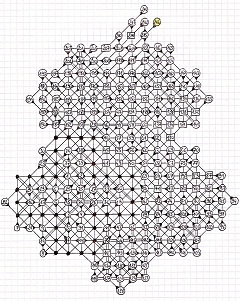
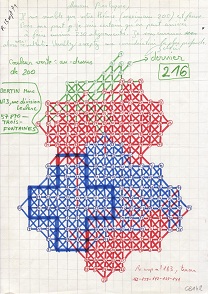
1974:
Marc
Bertin's record grid of 216 moves, and his original letter sent to Pierre Berloquin
On this webpage, the four 5T+ record grids are displayed
using a notation proposed in 1974 by J.-P. Roquier: the move numbers
of "bonus" dots (therefore not generating the line from which they
belong) are
surrounded by a square instead of a circle, and the "bonus" lines
are double-lined. Science & Vie published Bertin's grid in November 1974,
rotated, and without its move numbers:

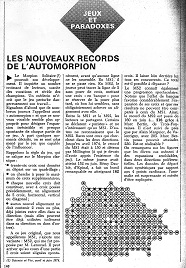

Science & Vie, November 1974: on
the right, publication of
Bertin's 5T+ (MS2) grid of 216 moves
In the middle, publication of Daubié's
grid of 162 moves which was at that time the 5T (MS1) record.
Improvable record?
Is it possible to improve Bertin's record? Because
Marc Bertin says that he was trying to find an optimal geometric configuration, here
is a grid inspired by the beginning of his game, but symmetrizing the two sides.
It is a "correct" final 5T+ grid, and also 5T, because it has the
same number of lines of five dots as the number of dots minus 36 (the initial cross having 36 dots)... but it is probably not playable. This grid has 253 moves:
you can check that it has 66 horizontal + 65 vertical
+ 61 diagonal/ + 61 diagonal\ = 253 lines, and 253 + 36 = 289
dots.
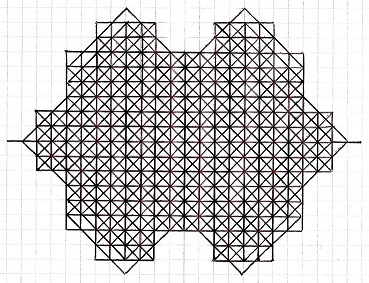
November
2011: 5T/5T+ final grid of 253 moves
by Christian Boyer...
... but probably not playable.
And it is possible again to improve the number
of moves: see a "correct" final 5T/5T+
grid of 317 moves, more than
one hundred more moves that Bertin's record!
Maybe somebody will be able to use these grids,
part of them or a modified part, and obtain a
playable 5T+ grid of more than 216 moves? This could beat Bertin's record!
5T++ game
We can also imagine a new "5T++" variant,
the above final grids of 253 and 317 moves becoming playable. When the game is stopped by
there being no more dot and line possible, we have the right to borrow dots, but
with the obligation to refund these dots before the end of the game. Then
of course the shape and the place of the 36 initial dots have no more impact.
This variant was named "MS2 bis" in Science & Vie, but no
record grid or score was given. An astonishing MS2 score of 250 moves by Robert
Féron was briefly mentionned in the November 1975 issue, but
Féron's grid found again in Berloquin's archives is
not correct, neither MS2 nor MS2 bis: its numbers of dots and lines do not
match. Today, the 5T++ record is my grid of 317 moves.
Previous record grids
The previous 5T+ record grids of 1974 were never
given in Science & Vie, only the scores of Lerouxel and Marguier
were mentionned. Thanks to Berloquin's archives, I am pleased
to publish them for the first time.
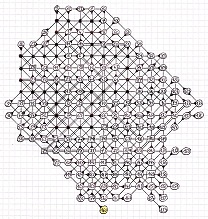
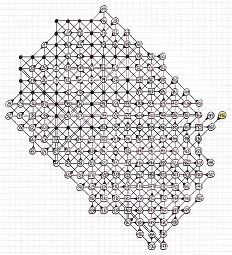
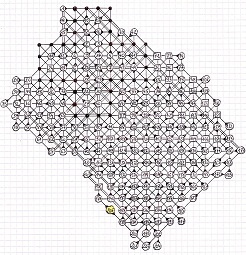
1974: Roland Lerouxel's grid of 160 moves, Jean-Pierre Roquier's
grid of 192 moves, Alain Marguier's grid of 205 moves
A few years before the three grids
above, Michel Broca found a better grid, when he was a young student in
Paris, in 1969, 70 or 71, as mentioned at the top of this page. But unfortunately
his result was never published: he learnt only by reading my website that in 1974 Science
& Vie had published articles on this game... He kindly sent
me his old grid in January 2012.
After the Ecole Poytechnique (1971),
Michel Broca worked for ten years in IT consulting, then at Générale
des Eaux which is now Veolia Eau, in computing and consumer management. He
likes genelaogy, and card games such as bridge and barbu.
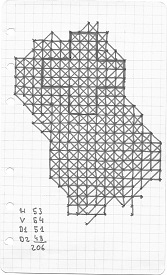
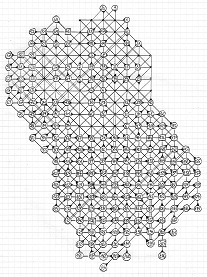
1969, 70, or 71: Michel Broca's
grid of 206 moves (on the left
his original old grid, on the right the checked grid)
Other interesting and more recent grids,
and 5T+ software
These two interesting 5T+ grids below were
constructed in 2004 and 2010, before the creation of this webpage in 2011. So, their authors
did not know the old French records of 1974 revealed above.
In Poland, Morpion Solitaire is named "Kreski" or
"Krechy" (two words meaning "lines"). Krzysztof Lorys,
currently professor at University of Wroclaw, proposed this 5T+ variant in 2000,
during the Polish Olympiads of Informatics. People continued to play after the
Olympiads, and the best grids obtained were 197 moves in 2002, then 199 moves
in 2004, both created by Zbigniew
Galias. There is an applet playing at 5T+ directly in your internet browser,
written by K. Lorys. Click three times for each move:
1) on the added dot, 2) on the beginning of the line, 3) and on the end of the line.
If you want to cancel your previous move, click on "Cofnij". If you
want to start a new game, click on "Nowa
gra".
Using Lineapolis
and its "Bonus mode" equivalent to 5T+, software created by
Dariusz Gierlotka (also Poland), Jean-Luc Coursel
(France) obtained the record of 209 moves on his PocketPC. An excellent score!
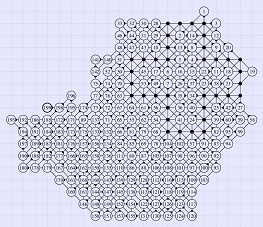

Sept.
2004 (on the left): Zbigniew Galias's grid of 199 moves
/ Sept. 2010 (on the right): J.-L. Coursel's grid of 209
moves
Coursel's grid as displayed by Lineapolis, but image slightly modified with the
36 dots of the initial cross colored in yellow.
© Christian Boyer, www.morpionsolitaire.com














